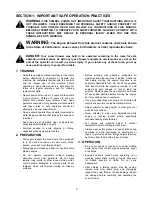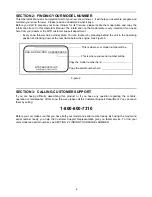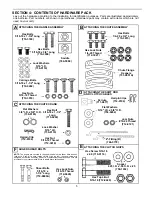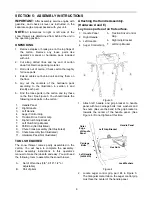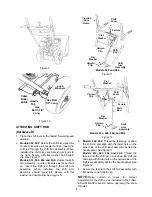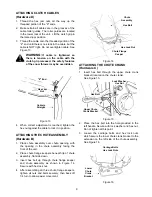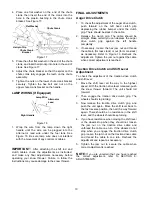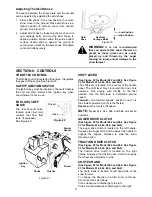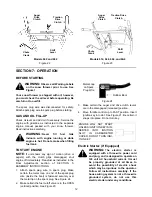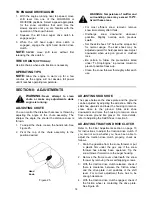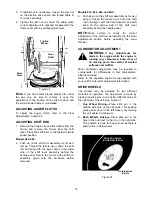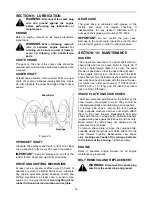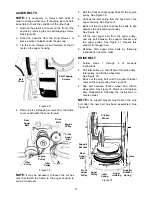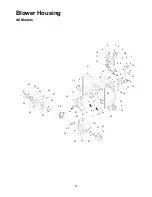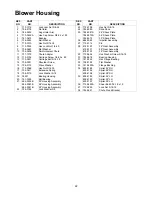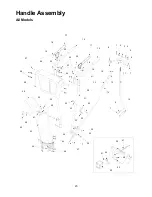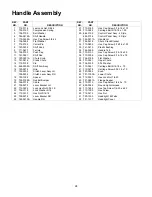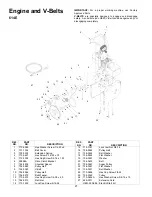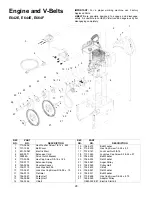
13
Follow all instructions carefully. Determine that your
house wiring is a three wire grounded system. Ask a
licensed electrician if you are not certain. If your
house wiring system is not a three-wire grounded
system, do not use this electric starter under any
conditions. If your system is grounded and a three-
hole receptacle is not available at the point your
starter will normally be used, one should be installed
by a licensed electrician.
When connecting the power cord, always connect
cord to starter on engine first, then plug the other
end into a three-hole grounded receptacle.
When disconnecting the power cord, always unplug
the end from the three-hole grounded receptacle
first.
1.
Make certain the auger drive and traction drive
clutch grips are in the disengaged (released)
position.
2.
Move throttle control up to FAST position. Insert
ignition key into slot. Refer to Figure 21. Be
certain it snaps into place. Do not turn key.
3.
Rotate choke knob to OFF position.
4.
Connect power cord to switch box on engine.
Plug the other end of power cord into a three-
hole, grounded 120 volt AC receptacle.
5.
Push starter button on top of the engine to crank
engine. As you crank the engine, move choke
knob to FULL choke position.
6.
When engine starts, release starter button, and
move choke gradually to OFF. If engine falters,
move choke immediately to FULL and then
gradually to OFF.
7.
Repeat steps 6 and 7 until engine starts. If
engine fails to start, repeat steps 5, 6, and 7 until
engine starts.
8.
As engine warms up and begins to operate
evenly, rotate choke knob slowly to OFF
position. If engine falters, return to FULL choke,
then slowly move to OFF position.
Recoil Starter.
1.
Make certain the auger drive and traction drive
clutch grips are in the disengaged (released)
position.
2.
Move throttle control up to FAST position. Insert
ignition key into slot. Refer to Figure 21. Be
certain it snaps into place. Do not turn key.
3.
Rotate choke knob to FULL choke position (cold
engine start).
If engine is warm, place choke in OFF position
instead of FULL.
4.
Push primer button two or three times. Refer to
Figure 21. If engine is warm, push primer button
once only.
NOTE:
Always cover vent hole in primer button
when pushing. Additional priming may be necessary
for first start if temperature is below 15
o
F.
5.
Grasp starter handle (refer to Figure 21) and pull
rope out slowly, until it pulls slightly harder. Let
rope rewind slowly.
6.
Pull starter handle rapidly. Do not allow handle
to snap back. Allow it to rewind slowly while
keeping a firm hold on the starter handle.
7.
Repeat steps 6 and 7 until engine starts. If
engine fails to start, repeat steps 5, 6 and 7 until
engine starts.
TO STOP ENGINE
1.
Run engine for a few minutes before stopping to
help dry off any moisture on the engine.
2.
To help prevent possible freeze-up of starter,
proceed as follows.
Electric Starter:
Connect power cord to switch box on engine, then to
120 volt AC receptacle. With the engine running,
push starter button and spin the starter for several
seconds. The unusual sound made by spinning the
starter will not harm engine or starter. Disconnect
the power cord from receptacle first, and then from
switch box.
Recoil Starter:
With engine running, pull starter rope with a rapid,
continuous full arm stroke three or four times. Pulling
the starter rope will produce a loud clattering sound,
which is not harmful to the engine or starter.
3.
To stop engine, remove the ignition key. Do not
turn key. Disconnect the spark plug wire from
the spark plug to prevent accidental starting
while equipment is unattended.
NOTE:
Do not lose ignition key. Keep it in a safe
place. Engine will not start without the ignition key.
4.
Wipe all snow and moisture from the carburetor
cover in the area of the control levers. Also,
move control levers back and forth several
times. Leave throttle control lever in the STOP or
OFF position. Leave choke control in the FULL
choke position.


